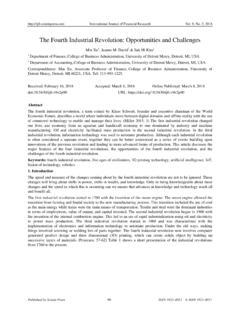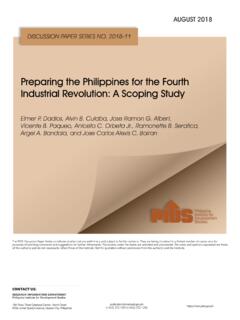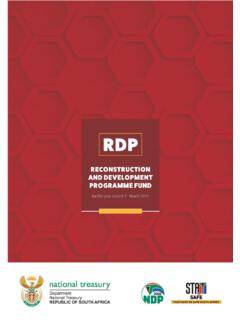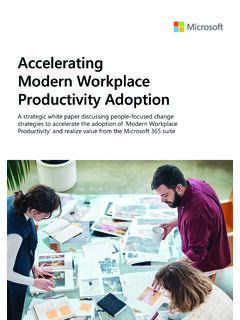Transcription of ‘The Fourth Industrial Revolution: Introduction and Overview’
1 The Fourth Industrial revolution : Introduction and Overview Fiona TregennaTopics for today What is the Fourth Industrial revolution / Industry [4IR]? How is it different? Developing countries Impact on employment State of the literature Thinking about policy implicationsWhat is 4IR? Term apparently first used in 2016 by World Economic Forum (Klaus Schwab) Dramatic change in pace and scope of automation of tasks previously done by humans Blurring of boundaries between the physical, biological and digital spheres Robotics; Artificial Intelligence (AI); Internet of Things (IoT) and Industrial Internet of Things (IIoT); cyber-physical systems; augmented reality (AR); virtual reality (VR); biotechnology; nanotechnology; autonomous vehicles; cloud computing; 3D background First Industrial revolution Late 18C and early 19C Industrialisation Use of water and steam to mechanise production Steam engine Second Industrial revolution +1970 1914 Use of electricity for mass production Electricity, combustion engine, steel, chemical synthesis, large factories, assembly linesHistorical background Third Industrial revolution 1980s onwards Digital revolution Use of electronics and ICT to automate production ICT, internet and computersHow is 4IR different?
2 Is it really a revolution or just a lot of hype? Not linear stages But it is qualitatively different and new, and irreversible Distinguished by Exponential velocity Wide-ranging scope Systemic impact4IR in SA and developing countries We are still undergoing elements of earlier Industrial revolutions 4IR still nascent International diffusion of 4IR is exponentially faster than earlier Industrial revolutions Estimates of how many jobs are vulnerable to being replaced by machine vary but it is clear that developing countries are more susceptible to automation compared to high-income countries. (Millington, 2017)How is employment likely to be affected? Multiple channels affecting Overall number of jobs Composition of employment (by skills level, sector etc.) Nature of work, work processes and the workplaceOverview of literature Academic studies; policy reports; business press and media Deal with various aspects of 4IR from various disciplines (engineering, economics, politics etc.)
3 Theoretical analyses; empirical analyses of what has happened sofar; projections of likely short-to medium-term impact; futuristic projectionsOverview of literature employment impact Recent burgeoning of studies analysingimpact on employment Empirical studies mostly focus on advanced economies (especially USA and Germany) Little on practical policy optionsImportant contributions on the impact of 4IR on jobs include: Frey & Osborne (2017) The future of employment: how susceptible are jobs to computerisation? Brynjolfsson& McAfee (2014) The Second Machine Age: Work, Progress, and Prosperity in a Time of Brilliant Technologies Autor(2015) Why are there still so many jobs? The history and future of workplace automation Acemoglu& Restrepo(2017) Robots and jobs: evidence from US labormarkets Ford (2015) The Rise of the Robots: Technology and the Threat of Mass UnemploymentEmerging findings from the literature Impact on total employment Lack of consensus Mass technological unemployment ?
4 Some argue that dystopic future of job destruction is overestimated/alarmist There will be job displacement/destruction and job creation (generally for different people) Automation can potentially raise productivity and earnings for some people But very strong evidence of largenet negative impactEmerging findings from the literature Impact on composition of employment Clear that there will be uneven impact, by occupation, sector, skills level etc. Certain types of jobs are most vulnerable Growing number of empirical studies internationally, identifying jobs most likely to be affected Impact on distribution Effect on incomes and quality of life depends on what happens to surplus Likely rise in inequalityWhich jobs most likely to be affected Depends on degree of automatability how routine and codifiableare tasks Overall, lower-skilled jobs more vulnerable than high-skilled, but not straight correlation This is one difference from previous types of automation some white-collar jobs now more vulnerable than some blue-collar jobs Less vulnerable jobs are those involving creativity, social interaction, high levels of dexterity.
5 Lot of variation amongst tasksPolicy implications Employment outcomes not cast in stone policy can influence to some extent The less prepared and proactive a country is, the higher job losses likely to be Direct due to changing nature of domestic production Indirect due to loss of international market shares Should policy focus on Minimisingjob losses, and/or Reskilling workers in vulnerable jobs, and/or How to distribute costs and benefits of 4IR?Further work on this paper Literature review Organising, synthesising, summarising, critiquing the existing literature and drawing out particular implications for SA










